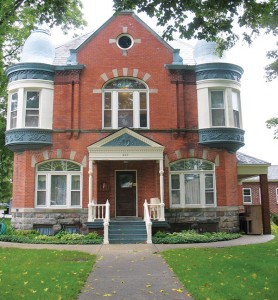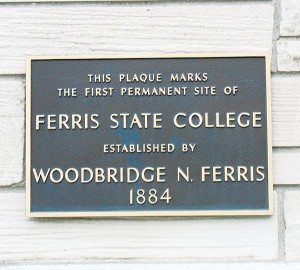Big Rapids History has played an important role in shaping FSU
As the university celebrates its 125th anniversary, the Ferris community reflects upon its history. Many events will be taking place throughout the year to honor the school’s roots and the people, events, and places on campus that have helped to mold FSU into what it has become today.
Entwined with that history, but perhaps not so heavily stressed, is the story of the city of Big Rapids itself. The city has a unique and interesting story to tell and has changed and grown alongside the university during these 125 years.
The exact “founding date” of the City of Big Rapids is a little confusing, as the area was originally called Leonard. The name change occurred in 1859 but, name aside, the first settlers came to the area in 1851. The area’s official incorporation as “The City of Big Rapids” took place in 1869.

During the roughly 15 years between the establishment of the city and the founding of Ferris College, the city grew considerably in size due to the booming logging industry. This occurred despite a huge fire in April of 1869 that burned down a large portion town.
Many sites within the city proper, and township of, Big Rapids are registered historic sites with the Michigan History Division of the State of Michigan.
One of these sites is the Old Mecosta County Jail located on Stewart Street. The jail was built in 1893, just nine short years after the founding of Ferris State College. According to the State of Michigan’s website, the building is “the oldest public structure in the original plat of the village of Big Rapids,” and was used as the county jail and sheriffs residence until 1965. Each year around Halloween, the Jail is transformed into a “Haunted Jail.” Many Ferris Students are involved in the process as well as local businesses and organizations.
A trip to downtown Big Rapids will lead you to a few more registered historic sites. The Nisbett Building, which houses the large clock tower, began construction in 1885. Daniel F. Comstock, who originally financed the huge project, went bankrupt soon after. The building remained half-finished until in 1900 when William P. Nisbett bought it from the Michigan Trust Company of Grand Rapids.

The Nisbett building is one of the more noticeable down town buildings due to its clock tower and large granite pillars.
Located diagonally from the Nisbett Building on the corner of Maple and Michigan, lies the original site of the first permanent site of the university, the Northern Bank Building. Now the site of Fifth Third Bank, this building and many others in the down town area, were used by the college in its infancy as classroom space.
As the University has grown it has drawn students, faculty, and other members of the Ferris community from all throughout the state of Michigan and beyond. Though the association to Ferris is easy enough for these new members to make, it may be less simple to draw a lasting tie to the community surrounding it.
It may help to remember that Ferris State University was originally to provide the people of the area with the opportunity to learn and grow. It has a rich history that is directly connected to that of the city of Big Rapids. The ties between the school and the local community, past and present, are important, relevant and interesting.
If you are interested in learning more about local history you can visit the Mecosta County Historical Society museum located at 129 N Stewart Ave.


